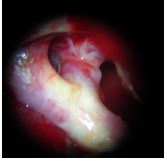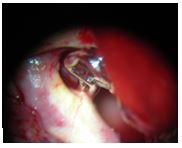A 58-year-old bank manager complained of sudden, severe headache after a tiring day at work. He claimed that it was the worst headache of his life, and it was accompanied by vomiting and dizziness. He was immediately brought to the nearest hospital emergency room.
On examination, the patient was awake, alert, and able to answer questions and follow commands. He still complained of headache with an intensity of 8/10. His neck was also stiff. His blood pressure was high at 160/100. It turned out that he had been diagnosed to have hypertension 2 years ago but he did not take his medicine regularly. He also continued to smoke cigarettes despite his doctor’s advice.
CT scan of the brain revealed blood in the subarachnoid space, which suggests that the bleeding may have come from a ruptured aneurysm. Because of this finding, a brain angiogram was done which showed a ruptured aneurysm of the internal carotid artery near the takeoff of the Pcomm (posterior communicating) artery.
An aneurysm is an out pouching or “ballooning” of the wall of a blood vessel. Because the ballooned wall is thinner and weaker, aneurysms are prone to rupture. Some patients remain awake and well after a rupture, but other patients may become drowsy or even comatose.
Ruptured aneurysms require immediate treatment to prevent them from rupturing again and causing damage to the brain. Treatment options include surgical clipping or endovascular coiling.
The patient underwent surgical clipping of the aneurysm. During clipping, an aneurysm clip (please see pictures) is placed across the neck of the aneurysm, preventing blood from flowing into it and causing another rupture. The surgery went well and the patient made a full recovery. He was advised to take his blood pressure pills regularly and to stop smoking, since hypertension and smoking are risk factors for aneurysm development. He was also advised to exercise regularly and to have a low-fat, low-salt diet.
Aneurysm before clipping After clipping
  |